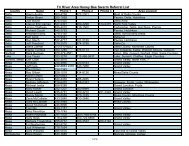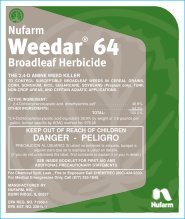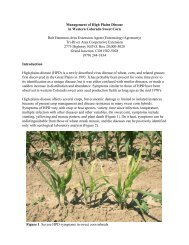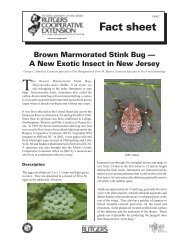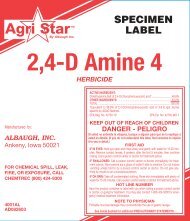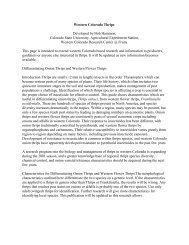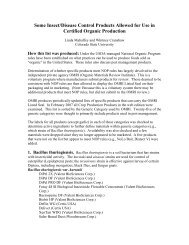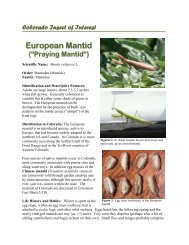UT fact sheet - Western Colorado Insects
UT fact sheet - Western Colorado Insects
UT fact sheet - Western Colorado Insects
You also want an ePaper? Increase the reach of your titles
YUMPU automatically turns print PDFs into web optimized ePapers that Google loves.
Figs. 2, 3, and 4. Left to right: Spotted wing drosophila (SWD) serrated ovipositor and egg (photo insert by Steve Valley); SWD larva; SWD<br />
pupa. Photos by E. Beers.<br />
Seasonal Emergence: Unknown for Utah. Washington<br />
State University estimates SWD emergence between late<br />
May and early June (514 degree days o F, base temp.<br />
48 o F).<br />
Important Behaviors: Can lay eggs in unripe, ripe,<br />
overripe, shriveled, or spoiled fruit. Adults prefer to feed<br />
on damaged or fermenting fruit.<br />
MONITORING METHODS<br />
Control is not recommended unless SWD is caught in<br />
monitoring traps, fruit injury is detected, or a high-value<br />
crop needs protecting. The following traps can be used<br />
for monitoring:<br />
• Prepare bait and add to cup: mix 0.25 oz yeast (one<br />
package) + 4 teaspoons sugar + 12 fl oz water, or<br />
2-3” of apple cider vinegar as a substitute for the<br />
yeast mixture.<br />
• Add 1 to 2 drops of dish soap (optional, but will<br />
improve fly capture).<br />
• Attach lid.<br />
• Hang traps at fruit level. In low-growing fruits such as<br />
strawberries, sink traps 2-3” in the ground.<br />
Clear Cup Trap: For homeowners or low-budget growers,<br />
simple traps can be made from a 16 to 32 oz clear plastic<br />
cup and lid, hanger, bait solution, twist-tie or paper clip,<br />
and a yellow sticky card.<br />
• On one side of the cup, drill four to six, 3/16” holes in<br />
the upper portion of the cup.<br />
• Drill two holes on opposite sides of the cup to put<br />
hanger through (to hang trap).<br />
• Put yellow sticky card in cup by attaching to a twisttie<br />
put through two small holes in the top of the lid.<br />
Optional, but may make monitoring easier.<br />
Fig. 5. Homemade SWD cup trap. Flies attracted to the<br />
bait enter through the holes and land on the yellow<br />
sticky card or in the bait solution. Photos by BC Ministry<br />
of Agriculture and Lands.<br />
Fig. 6. Contech fruit fly trap (left), and McPhail trap (right).<br />
Commercially Available Traps: Easy-to-use commercial<br />
traps are available from Contech (Fruit Fly Trap) for about<br />
$10 for a two-pack (Fig. 6). McPhail traps from ISCA Tech.<br />
are more complex to use and cost about $14 per trap<br />
(available in bulk order rates at $11 each). There are<br />
many other similar traps on the market that work on the<br />
same principles. Homemade and commercial traps are<br />
equally effective at catching SWD. See “Trap Sources” at<br />
end of publication for contact information.<br />
Liquid Baits: The two best bait solutions to use in traps<br />
are apple cider vinegar, or a sugar-water-yeast solution.<br />
The yeast solution is likely a better attractant when SWD<br />
populations are low. If you are trapping to detect the<br />
presence of SWD, you may want to use the yeast solution.<br />
The downside of the yeast solution is that it needs to<br />
be changed at least every 2 weeks, is messy, and has<br />
a bad odor. Once a SWD population is confirmed,<br />
you can switch to the vinegar solution for monitoring.<br />
All liquid baits should be changed weekly for optimal<br />
performance.<br />
Page 2





